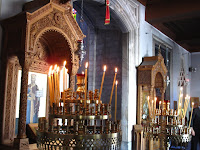
The airports around London were all affected by the heavy snowfalls so, with great concern, we followed the daily reports in the days leading up to Christmas.
Even the train service to Gatwick (the airport from which we flew to Crete) was suffering severe delays.

So we set out extra early on Christmas Eve, to reach Gatwick airport. The trains by then were behaving perfectly, so we hoped the same was true of the airport.
After checking in, we watched the departures board with increasing anxiety, as all the flights before and after ours were delayed. The flight prior to ours was delayed by over 5 hours, and as ours just said 'Please wait', we were not sure what might happen.

We had booked a flight with a 3-hour stopover in Athens (no direct flights in winter), but unfortunately, the airline had changed our outward flight, so we only had a 1-hour stopover. As our expected boarding time passed, we still only had 'Please wait' on the board. Finally a gate number appeared, and as we reached it, the PA system announced the sad saga of delays for another flight. We weren't assured of our connection though, as the departure time came and went, and we finally left 40 minutes late.

The flight landed 25 minutes late, but a hostess told us we could make it. She had obviously never tried herself, as we found we had to go through passport control and leave international and enter the domestic terminal. Then after finding our gate number and walking VERY briskly down seemingly never-ending corridors, we finally found ourselves at a security queue. A bit of creative queue jumping was called for, and we took off down more long corridors to find our gate, where the plane was just boarding, and it actually left a few minutes early.


As we waited hopefully for our luggage, we talked to another traveller we recognised from the London flight, to see it we had come the long way round, as we wondered if we had been misdirected, and there was actually a direct route to be taken for a transfer.

He assured us he had done this trip many times before, and the only way was to go out and back in through security, just as we had done, which made us wonder how many on the London flight had failed to make the connection. We were extremely delighted to find our bags had also made it through to Heraklion, found our rental car, and made our way to Zorbas Beach, our accommodation for the 10 nights ahead.

 The last day of another year, and we choose to head west again to visit the third largest city on the island – Rethymno. This is also a Venetian town, like Chania, with the largest fortress the Venetians built anywhere. We parked on the far side of the fortress, and it seemed to go on forever, as we walked around it's base. We drank the best coffee on the island, sitting beside the small harbour.
The last day of another year, and we choose to head west again to visit the third largest city on the island – Rethymno. This is also a Venetian town, like Chania, with the largest fortress the Venetians built anywhere. We parked on the far side of the fortress, and it seemed to go on forever, as we walked around it's base. We drank the best coffee on the island, sitting beside the small harbour.













































